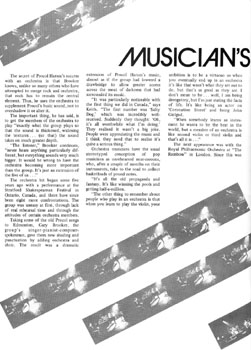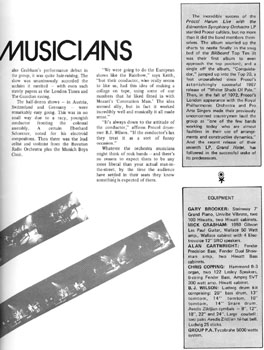Procol HarumBeyond |
|
|
PH on stage | PH on record | PH in print | BtP features | What's new | Interact with BtP | For sale | Site search | Home |
|
The secret of Procol Harumís success with an orchestra is that Brooker knows, unlike so many others who have attempted to merge rock and orchestra, that rock has to remain the central element. Thus, he uses the orchestra to supplement Procolís basic sound, not to overshadow it or alter it.
The important thing, he has said, is to get the members of the orchestra to play "exactly what the group plays so that the sound is thickened, widening the texturesÖ (so that) the sound takes on much greater depth.

"The listener," Brooker continues, "never hears anything particularly different, but everything sounds very much bigger. It would be wrong to have the orchestra becoming more important than the group. Itís just an extension of the five of usÖ"
The orchestra bit began some five years ago with a performance at the Stratford Shakespearean Festival in Ontario, Canada, and there have since been eight more confrontations. The group was uneasy at first, through lack of real rehearsal time and through the attitudes of certain orchestra members.
Taking some of the old Procol songs to Edmonton, Gary Brooker, the groupís singer-pianist-composer-spokesman, gave them new shading and punctuation by adding orchestra and choir. The result was a dramatic extension of Procol Harumís music, almost as if the group had lowered a drawbridge to allow greater access across the moat of darkness that had surrounded its music.
"It was particularly noticeable with the first thing we did in Canada," says Keith. "The first number was Salty Dog, which was incredibly well-received. Suddenly they thought: ĎOh, itís all worthwhile what Iím doing.í They realised it wasnít a big joke. People were appreciating the music and I think they need that to realise itís quite a serious thing."
Orchestra musicians have the usual stereotyped conception of pop musicians as unrehearsed near-morons, who, after a couple of months on their instruments, take to the road to collect basketloads of pound notes.
"Itís all the old propaganda and fantasy. Itís like winning the pools and getting half-a-million.

"The other thing to remember about people who play in an orchestra is that when you learn to play the violin, your ambition is to be a virtuoso so when you eventually end up in an orchestra itís like that wasnít what they set out to do, but thatís as good as they are. I donít mean to be Ö well, I am being derogatory, but Iím just stating the facts of life. Itís like being an actor on Coronation Street and being John Gielgud.
"When somebody learns an instrument he wants to be the best in the world, but a member of an orchestra is like second violin or third violin and thatís all it isÖ"
The next appearance was with the Royal Philharmonic Orchestra at The Rainbow in London. Since this was also Grabhamís performance début in the group, it was quite hair-raising. The show was unanimously accorded the acclaim it merited Ė with even such stately papers as the London Times and The Guardian raving.
The half-dozen shows Ė in Austria, Switzerland and Germany Ė were remarkably easy going. This was in no small way due to a racy, youngish conductor fronting the colossal assembly. A certain Eberhard Schoerner, noted for his electroid compositions. Then there was the lead cellist and violinist from the Bavarian Radio Orchestra plus the Munich Boys Choir.
"We were going to do the European shows like the Rainbow," says Keith, "but their conductor, who really seems to like us, had this idea of making a collage on tape, using some of our numbers that he liked fitted in with Mozartís Coronation Mass. The idea seemed silly, but in fact it worked incredibly well and musically it all made sense."
"Itís always down to the attitude of the conductor," affirms Procol drummer BJ Wilson. "If the conductorís lax they treat it as a sort of funny occasion."
Whatever the orchestra musicians might think of rock bands Ė and thereís no reason to expect them to be any more liberal than your actual man-in-the-street, by the time the audience have settled in their seats they know something is expected of them.
|
The incredible success of the Procol Harum Live with the Edmonton Symphony Orchestra LP startled Procol cultists, but no more than it did the band members themselves. The album scurried up the charts to nestle finally in the snug bed of the Billboard Top Ten (it was their first album to even approach the top positon [sic]); and a single off the album, Conquistador, jumped into the Top 20, a feat unparalleled since Procolís astonishingly successful 1967 release of Whiter Shade of Pale. Then, in the fall of 1972, Procolís London appearance with the Royal Philharmonic Orchestra and Pro Arte Singers made their previously unconcerned countrymen laud the group as "one of the few bands working today who are almost faultless in their use of arrangements and constructive dynamics." And the recent release of their seventh LP, Grand Hotel, has followed in the successful wake of its predecessors |
*
|
EQUIPMENT GARY BROOKER: Steinway 7í Grand Piano, Univibe Vibrato, two 100 Hiwatts, two Hiwatt cabinets. MICK GRABHAM: 1959 Gibson Les Paul Guitar, Wallace 50 Watt amp., Wallace cabinet with 4 Electrovoice 12" SRO speakers. ALAN CARTWRIGHT: Fender Precision Bass, Fender Dual Showman amp, two Hiwatt Bass cabinets. CHRIS COPPING: Hammond B-3 organ, two 122 Lesley Speakers, 6-string Fender Bass, Ampeg SVT 300 watt amp. Hiwatt cabinet. BJ WILSON: Ludwig drum kit comprising: 26" bass drum, 13" tomtom, 14" tomtom, 16" tomtom, 14" Snare drum, Avedis Zildjian cymbals Ė 8", 12", 18", 22" and 24". Large cowbell; two pairs Avedis Zildjian hi-hat bell. Ludwig 2S sticks. GROUP PA: Tycobrahe 5000 watts system. |
|
PH on stage | PH on record | PH in print | BtP features | What's new | Interact with BtP | For sale | Site search | Home |